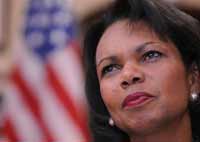Condoleezza Rice goes to Stanford University, not to McCain’s ticket
US Secretary of State Condoleezza Rice said on Monday that she was not interested in the position of the vice president. It was previously rumored that Mrs. Rice was going to run for vice presidency on the Republican Party presidential ticket with Senator John McCain. However, the US State Department subsequently dispersed the rumors.

"I don't want to be, don't intend to be, won't be on the ticket," Rice told the Associated Press.
Rice said she was going to return to academic activities at Stanford University after George W. Bush’s term in the office ends.
"Let me just say, first of all, that Senator McCain is an extraordinary American, a really outstanding leader and obviously a great patriot. That said, I am going back to Stanford," Rice said.
Also read: Condoleezza Rice's anti-Russian stance based on sexual problems
The Secretary of State added that she would like to write a book about the changes that have been happening in US-led policies since 2001. Rice said that she was incredibly lucky to work as the National Security Advisor and then as the Secretary of State during a very important period for the United States.
Condoleezza Rice worked at Stanford University from 1993 to 1999, before she joined the Bush administration. Rice was hired by Stanford University as an Assistant Professor of Political Science (1981–1987). She was promoted to Associate Professor in 1987, a post she held until 1993. She was a specialist on the Soviet Union and gave lectures on the subject for the Berkeley-Stanford joint program led by UC Berkeley Professor George Breslauer in the mid-1980s.
At a 1985 meeting of arms control experts at Stanford, Rice's performance drew the attention of Brent Scowcroft, who had served as National Security Adviser under Gerald Ford. With the election of George H. W. Bush, Scowcroft returned to the White House as National Security Adviser in 1989, and he asked Rice to become his Soviet expert on the United States National Security Council. According to R. Nicholas Burns, President Bush was "captivated" by Rice, and relied heavily on her advice in his dealings with Mikhail Gorbachev and Boris Yeltsin.
Since she would have been ineligible for tenure at Stanford if she had been absent for more than two years, in 1991, she returned to Stanford. She was now taken under the wing of George P. Shultz (Ronald Reagan's Secretary of State from 1982-1989), who was a fellow at the Hoover Institution. Shultz included Rice in a "luncheon club" of intellectuals who met every few weeks to discuss foreign affairs. In 1992, Shultz, who was a board member of Chevron Corporation, recommended Rice for a spot on the Chevron board. Chevron was pursuing a $10 billion development project in Kazakhstan, and as a Soviet specialist, Rice knew the President of Kazakhstan, Nursultan Nazarbayev. She traveled to Kazakhstan on Chevron's behalf, and, in honor of her work, in 1993, Chevron named a 129,000-ton supertanker SS Condoleezza Rice. During this period, Rice was also appointed to the boards of Transamerica Corporation (1991) and Hewlett-Packard (1992).
At Stanford, in 1992, Rice volunteered to serve on the search committee to replace outgoing president Donald Kennedy. The committee ultimately recommended Gerhard Casper, the Provost of the University of Chicago. Casper met Rice during this search, and was so impressed that in 1993, he appointed her as Stanford's Provost, the chief budget and academic officer of the university (1993–1999), and she also was granted tenure and became full Professor in 1993 (1993–present). Rice was the first female, first minority, and youngest Provost at Stanford. She was also named a Senior Fellow of the Institute for International Studies, and a Senior Fellow (by courtesy) of the Hoover Institution.
Source: agencies
AP photo
Prepared by Dmitry Sudakov
Pravda.ru
Subscribe to Pravda.Ru Telegram channel, Facebook, RSS!

